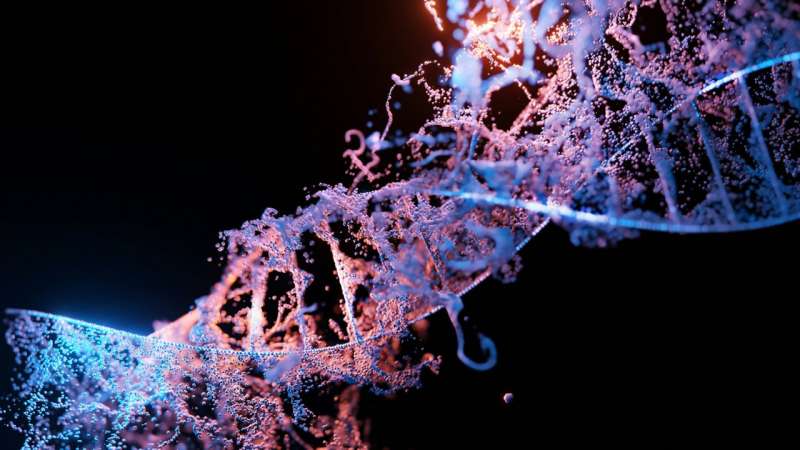This article has been reviewed according to Science X's editorial process and policies. Editors have highlighted the following attributes while ensuring the content's credibility:
fact-checked
peer-reviewed publication
trusted source
proofread
New technique reveals earliest signs of genetic mutations

Mutations are changes in the molecular "letters" that make up the DNA code, the blueprint for all living cells. Some of these changes can have little effect, but others can lead to diseases, including cancer. Now, a new study introduces an original technique, called HiDEF-seq, that can accurately detect the early molecular changes in DNA code that precede mutations.
The authors of the study, published in Nature, say their technique—HiDEF-seq, short for Hairpin Duplex Enhanced Fidelity Sequencing—could advance our understanding of the basic causes of mutations, in both healthy cells and in cancer, and how genetic changes naturally accumulate in human cells as people age.
Led by a team of researchers at NYU Langone Health, with collaborators across North America and in Denmark, the work helps to resolve the earliest steps in how mutations occur in DNA.
The new study is based on the understanding that DNA is made up of two strands of molecular letters, or bases. Each strand is composed of four types of letters: adenine (A), thymine (T), guanine (G), and cytosine (C). The bases of each strand pair with bases in the other strand in a specific pattern, with As pairing with Ts and Gs pairing with Cs. This allows the DNA code to be replicated and passed down accurately from one generation of cells to the next.
Importantly, mutations are changes in the DNA code that are present in both strands of DNA. For example, a base pair of G and C, with a G on one strand paired with a C on the other strand, can mutate to an A and T base pair.
However, researchers say, most mutations have their origins in DNA changes that are present in only one of the two DNA strands, and these single-strand changes, such as a mismatched G and T base pair, cannot be accurately identified using previous testing techniques.
These changes can occur when a DNA strand is not copied correctly during replication, as a cell divides into two cells, or when one of the two DNA strands is damaged by heat or by other chemicals in the body. If these single-strand DNA changes are not repaired by the cell, then the changes are at risk of becoming permanent double-strand mutations.
The HiDEF-seq technique was shown to detect double-strand mutations with extremely high accuracy, with an estimate of one recording error per 100 trillion base pairs analyzed. Moreover, HiDEF-seq detected changes in the DNA letter code while they were present on just one of the two strands of DNA, before they become permanent double-strand mutations.
"Our new HiDEF-seq sequencing technique allows us to see the earliest fingerprints of molecular changes in DNA when the changes are only in single strands of DNA," said senior study author Gilad Evrony, MD, Ph.D., a core member of the Center for Human Genetics & Genomics at NYU Grossman School of Medicine.
Because people with genetic syndromes linked to cancer are known to have higher rates of mutations in their cells than cells in people with no cancer predisposition, researchers began their experiments by describing the DNA changes in healthy cells from people with these syndromes.
Specifically, investigators worked with healthy cells from people with polymerase proofreading-associated polyposis (PPAP), a hereditary condition linked to an increased risk for colorectal cancer, and congenital mismatch repair deficiency (CMMRD), another hereditary condition that increases the likelihood of several cancers in children.
Using HiDEF-seq, researchers found a higher number of single-strand DNA changes in their cells, such as a T paired with a C in place of the original G paired with a C, than in the cells from people who did not have either syndrome. Moreover, the pattern of these single-strand changes was similar to the pattern observed in the double-strand DNA mutations for people with either syndrome.
Subsequent experiments were performed in human sperm, which are known to have among the lowest double-strand mutation rates of any human cell type.
Researchers found that the pattern of chemical damage, called cytosine deamination, observed by HiDEF-seq in single stands of DNA in sperm, closely matched the damage observed in blood DNA intentionally damaged by heat. This, the researchers say, suggests that the two patterns of chemical damage to DNA, one natural and the other induced, occur through a similar process.
"Our study lays the foundation for using the HiDEF-seq technique in future experiments to transform our understanding of how DNA damage and mutations arise," said Evrony, who is also an assistant professor in the Department of Pediatrics and the Department of Neuroscience and Physiology at NYU Grossman School of Medicine.
Single-strand changes in DNA occur continually as cells divide and multiply, and while layers of repair mechanisms fix most changes, some get through and become mutations.
"Our long-term goal is to use HiDEF-seq to create a comprehensive catalog of single-strand DNA mismatch and damage patterns that will help explain the known double-strand mutation patterns," said Evrony.
"In the future, we hope to combine profiling of single-strand DNA lesions, as obtained from HiDEF-seq, with the lesions' resulting double-strand mutations to better understand and monitor the everyday effects on DNA from environmental exposures."
Geneticists estimate that there are approximately 12 billion bases or individual DNA letters that can be damaged or mismatched in each human cell, as there are two copies of the genetic code, with one copy inherited from each parent.
Each of these copies comprise a double-stranded DNA spanning 3 billion base pairs. Evrony says that every base position in the genetic code is likely damaged or mutated at some point during an individual's lifetime in at least some cells.
More information: Gilad Evrony, DNA mismatch and damage patterns revealed by single-molecule sequencing, Nature (2024). DOI: 10.1038/s41586-024-07532-8. www.nature.com/articles/s41586-024-07532-8




















